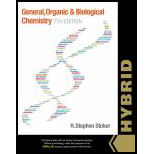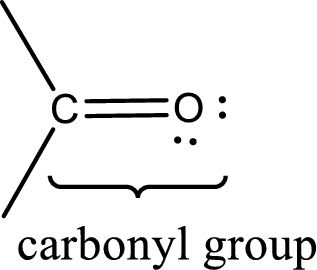
General, Organic, And Biological Chemistry, Hybrid (with Owlv2 Quick Prep For General Chemistry Printed Access Card)
7th Edition
ISBN: 9781305253070
Author: STOKER, H. Stephen
Publisher: Cengage Learning
expand_more
expand_more
format_list_bulleted
Concept explainers
Question
Chapter 15.1, Problem 1QQ
Interpretation Introduction
Interpretation:
The
Concept Introduction:
Carbonyl groups are the one which contain a double bond between carbon and oxygen atom.

Expert Solution & Answer
Want to see the full answer?
Check out a sample textbook solution
Students have asked these similar questions
What two chemicals can be reacted together to fom an ester?
A- An alcohol and a carboxylic acid
B- A carboxylic acid and an alkali
C- Two carboxylic acids
D-Non of these
Answer A
Answer B
Answer C
Answer D
▼
Part A
Which one of the following molecules is the most polar?
Oformic acid
Oethylamine
O butane
O acetylene
ethanol
Submit
Provide Feedback
Request Answer
Please help, why is it wrong? Explain woth clear answer please
Chapter 15 Solutions
General, Organic, And Biological Chemistry, Hybrid (with Owlv2 Quick Prep For General Chemistry Printed Access Card)
Ch. 15.1 - Prob. 1QQCh. 15.1 - Prob. 2QQCh. 15.2 - Prob. 1QQCh. 15.2 - Prob. 2QQCh. 15.2 - Prob. 3QQCh. 15.3 - Prob. 1QQCh. 15.3 - Prob. 2QQCh. 15.3 - Prob. 3QQCh. 15.4 - Prob. 1QQCh. 15.4 - Prob. 2QQ
Ch. 15.4 - Prob. 3QQCh. 15.4 - Prob. 4QQCh. 15.4 - Prob. 5QQCh. 15.5 - Prob. 1QQCh. 15.5 - Prob. 2QQCh. 15.5 - Prob. 3QQCh. 15.5 - Prob. 4QQCh. 15.5 - Prob. 5QQCh. 15.6 - Prob. 1QQCh. 15.6 - Prob. 2QQCh. 15.6 - Prob. 3QQCh. 15.7 - Prob. 1QQCh. 15.7 - Prob. 2QQCh. 15.8 - Prob. 1QQCh. 15.8 - Prob. 2QQCh. 15.9 - Prob. 1QQCh. 15.9 - Prob. 2QQCh. 15.10 - Prob. 1QQCh. 15.10 - Prob. 2QQCh. 15.10 - Prob. 3QQCh. 15.10 - Prob. 4QQCh. 15.11 - Prob. 1QQCh. 15.11 - Prob. 2QQCh. 15.11 - Prob. 3QQCh. 15.11 - Prob. 4QQCh. 15.11 - Prob. 5QQCh. 15.12 - Prob. 1QQCh. 15.12 - Prob. 2QQCh. 15 - Prob. 15.1EPCh. 15 - Prob. 15.2EPCh. 15 - Prob. 15.3EPCh. 15 - In terms of polarity, which carbonyl group atom...Ch. 15 - Prob. 15.5EPCh. 15 - What is the geometrical arrangement for the atoms...Ch. 15 - Prob. 15.7EPCh. 15 - Prob. 15.8EPCh. 15 - Prob. 15.9EPCh. 15 - Prob. 15.10EPCh. 15 - Prob. 15.11EPCh. 15 - Classify each of the following structures as an...Ch. 15 - Prob. 15.13EPCh. 15 - Prob. 15.14EPCh. 15 - Prob. 15.15EPCh. 15 - Prob. 15.16EPCh. 15 - Prob. 15.17EPCh. 15 - Prob. 15.18EPCh. 15 - Prob. 15.19EPCh. 15 - Prob. 15.20EPCh. 15 - Prob. 15.21EPCh. 15 - Prob. 15.22EPCh. 15 - Prob. 15.23EPCh. 15 - Prob. 15.24EPCh. 15 - Prob. 15.25EPCh. 15 - Prob. 15.26EPCh. 15 - Prob. 15.27EPCh. 15 - Prob. 15.28EPCh. 15 - Prob. 15.29EPCh. 15 - Prob. 15.30EPCh. 15 - Prob. 15.31EPCh. 15 - Prob. 15.32EPCh. 15 - Prob. 15.33EPCh. 15 - Prob. 15.34EPCh. 15 - Prob. 15.35EPCh. 15 - Prob. 15.36EPCh. 15 - Prob. 15.37EPCh. 15 - Prob. 15.38EPCh. 15 - Prob. 15.39EPCh. 15 - Prob. 15.40EPCh. 15 - Draw a structural formula for each of the...Ch. 15 - Prob. 15.42EPCh. 15 - Prob. 15.43EPCh. 15 - Prob. 15.44EPCh. 15 - Prob. 15.45EPCh. 15 - Prob. 15.46EPCh. 15 - Prob. 15.47EPCh. 15 - Prob. 15.48EPCh. 15 - Prob. 15.49EPCh. 15 - Prob. 15.50EPCh. 15 - Prob. 15.51EPCh. 15 - Prob. 15.52EPCh. 15 - Prob. 15.53EPCh. 15 - Prob. 15.54EPCh. 15 - Prob. 15.55EPCh. 15 - Prob. 15.56EPCh. 15 - Prob. 15.57EPCh. 15 - Prob. 15.58EPCh. 15 - Prob. 15.59EPCh. 15 - Prob. 15.60EPCh. 15 - Prob. 15.61EPCh. 15 - Prob. 15.62EPCh. 15 - Prob. 15.63EPCh. 15 - Prob. 15.64EPCh. 15 - Prob. 15.65EPCh. 15 - Prob. 15.66EPCh. 15 - Prob. 15.67EPCh. 15 - Which member in each of the following pairs of...Ch. 15 - Prob. 15.69EPCh. 15 - Prob. 15.70EPCh. 15 - Prob. 15.71EPCh. 15 - Prob. 15.72EPCh. 15 - Prob. 15.73EPCh. 15 - Prob. 15.74EPCh. 15 - Prob. 15.75EPCh. 15 - Prob. 15.76EPCh. 15 - Prob. 15.77EPCh. 15 - Prob. 15.78EPCh. 15 - Prob. 15.79EPCh. 15 - What is the chemical formula of the inorganic...Ch. 15 - Prob. 15.81EPCh. 15 - Which of the following compounds would react with...Ch. 15 - Prob. 15.83EPCh. 15 - Prob. 15.84EPCh. 15 - Which of the three compounds pentanal,...Ch. 15 - Prob. 15.86EPCh. 15 - Prob. 15.87EPCh. 15 - Prob. 15.88EPCh. 15 - Prob. 15.89EPCh. 15 - Prob. 15.90EPCh. 15 - Prob. 15.91EPCh. 15 - Prob. 15.92EPCh. 15 - Which carbon atom is the hemiacetal carbon atom in...Ch. 15 - Prob. 15.94EPCh. 15 - Prob. 15.95EPCh. 15 - Prob. 15.96EPCh. 15 - Prob. 15.97EPCh. 15 - Prob. 15.98EPCh. 15 - Prob. 15.99EPCh. 15 - Prob. 15.100EPCh. 15 - Prob. 15.101EPCh. 15 - Prob. 15.102EPCh. 15 - Prob. 15.103EPCh. 15 - Prob. 15.104EPCh. 15 - Prob. 15.105EPCh. 15 - Prob. 15.106EPCh. 15 - Prob. 15.107EPCh. 15 - Prob. 15.108EPCh. 15 - Prob. 15.109EPCh. 15 - Prob. 15.110EPCh. 15 - Prob. 15.111EPCh. 15 - Prob. 15.112EPCh. 15 - Prob. 15.113EPCh. 15 - Prob. 15.114EPCh. 15 - Prob. 15.115EPCh. 15 - Prob. 15.116EPCh. 15 - Prob. 15.117EPCh. 15 - Prob. 15.118EP
Knowledge Booster
Learn more about
Need a deep-dive on the concept behind this application? Look no further. Learn more about this topic, chemistry and related others by exploring similar questions and additional content below.Similar questions
- What is the IUPAC name of the following compound? CH,C NH2 Submit Answer Retry Entire Group 9 more group attempts rerarrow_forward2. Consider the following pairs of compounds. For each pair, predict which compound has greater solubility in water and explain why. Refer to the compound's ability to from hydrogen bonds. You may wish to review pages 111-112 in your textbook.arrow_forward20. Which of the following compounds consists of molecules that show geometrical (cis-trans) isomerism? a. 2-methylpropene b. 2-butene c. 2-methyl-2-butene d. more than one response is correct e. no correct responsearrow_forward
- On the following structure, select all of the atoms that can be donated in a hydrogen bond. When selecting be sure to click on the center of the atom. 5th attempt See Periodic Table See Hint H. -H- + SUBMIT ANSWER 4 VIEW SOLUTION 22 OF 25 QUESTIONS COMPLETED MacBook Air DII DD F12 80 888 F9 F10 F11 F6 F7 F8 F5 F4arrow_forwardProblem 2 A nitro group (-NO₂) effectively stabilizes a negative charge on an adjacent carbon atom through resonance: R. R. R R minor minor major Two of the following nitrophenols are much more acidic than phenol itself. The third compound is only slightly more acidic than phenol. Use resonance structures of the appropriate phenoxide ions to show why two of these anions should be unusually stable. LOH LOH R OH ago NO₂ NO₂2 2-nitrophenol 3-nitrophenol O₂N 4-nitrophenolarrow_forwardPlease answer: A, B, Carrow_forward
- glome Selected Answer: Answers: 1. HO 2. EtMgBr 3. H3O+ 1. HOT 2. EtMgBr 3. NaOH EtMgBr, followed by aqueous workup 1. HO 2. EtMgBr 3. H3O+ ? 1. LIAIH4 2. EtMgBr 3. NaOH OH OH OH OH O OMearrow_forwardcarbon trioxide please check if my answers are correctarrow_forwardA common property for both thiols and thioethers is very high boiling points ability to form strong hydrogen bonds a strong odor no correct responsearrow_forward
arrow_back_ios
arrow_forward_ios
Recommended textbooks for you
 Organic And Biological ChemistryChemistryISBN:9781305081079Author:STOKER, H. Stephen (howard Stephen)Publisher:Cengage Learning,
Organic And Biological ChemistryChemistryISBN:9781305081079Author:STOKER, H. Stephen (howard Stephen)Publisher:Cengage Learning, General, Organic, and Biological ChemistryChemistryISBN:9781285853918Author:H. Stephen StokerPublisher:Cengage Learning
General, Organic, and Biological ChemistryChemistryISBN:9781285853918Author:H. Stephen StokerPublisher:Cengage Learning

Organic And Biological Chemistry
Chemistry
ISBN:9781305081079
Author:STOKER, H. Stephen (howard Stephen)
Publisher:Cengage Learning,

General, Organic, and Biological Chemistry
Chemistry
ISBN:9781285853918
Author:H. Stephen Stoker
Publisher:Cengage Learning